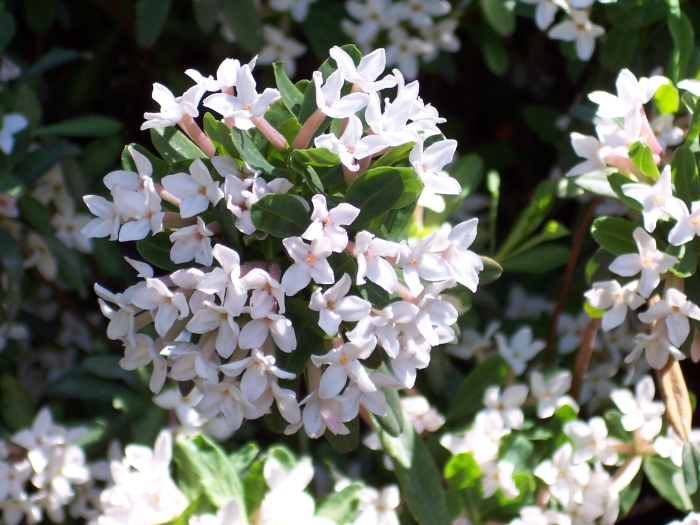Burkwood’s Daphne
(Daphne ×burkwoodii)
Burkwood’s Daphne (Daphne ×burkwoodii)
/
/

A. Barra
CC BY 3.0
Image By:
A. Barra
Recorded By:
Copyright:
CC BY 3.0
Copyright Notice:
Photo by: A. Barra | License Type: CC BY 3.0 | License URL: https://creativecommons.org/licenses/by/3.0 | Uploader: Cillas | Publisher: Wikimedia Commons | Title: Daphne_x_burkwoodii.jpg | Notes: User created page with UploadWizard |



















Estimated Native Range
Summary
Daphne ×burkwoodii, commonly known as Burkwood’s Daphne, is a semi-evergreen shrub resulting from a cross between D. caucasica and D. cneorum. It typically grows to a height of 2-3 feet (0.6-0.9 meters) and a width of 3-4 feet (0.9-1.2 meters). Although of garden origin, its parent species are native to the rocky hillsides and scrublands of Europe. Burkwood’s Daphne has a compact, mounded form and is renowned for its fragrant flowers, which bloom in clusters of pink, purple, and white in the spring. The blossoms are highly showy and attract pollinators.
This plant is valued for its delightful scent and is often used in border plantings, as a foundation plant, or in scented gardens. It is relatively low-maintenance but requires well-drained soil and protection from harsh afternoon sun. Burkwood’s Daphne is susceptible to root rot if overwatered or planted in poorly drained soils. It may also suffer from viral diseases and pests such as scale insects. Gardeners should be cautious of its toxic berries and sap. Despite these concerns, its ornamental appeal makes it a popular choice for residential gardens.CC BY-SA 4.0
This plant is valued for its delightful scent and is often used in border plantings, as a foundation plant, or in scented gardens. It is relatively low-maintenance but requires well-drained soil and protection from harsh afternoon sun. Burkwood’s Daphne is susceptible to root rot if overwatered or planted in poorly drained soils. It may also suffer from viral diseases and pests such as scale insects. Gardeners should be cautious of its toxic berries and sap. Despite these concerns, its ornamental appeal makes it a popular choice for residential gardens.CC BY-SA 4.0
Plant Description
- Plant Type: Shrubs
- Height: 2-3 feet
- Width: 3-4 feet
- Growth Rate: Moderate
- Flower Color: Pink, Purple, White
- Flowering Season: Spring
- Leaf Retention: Semi-deciduous
Growth Requirements
- Sun: Part Shade
- Water: Medium
- Drainage: Medium
Common Uses
Bank Stabilization, Bee Garden, Bird Garden, Border Plant, Butterfly Garden, Deer Resistant, Drought Tolerant, Fire Resistant, Fragrant, Groundcover, Hedges, Hummingbird Garden, Low Maintenance, Potted Plant, Rabbit Resistant, Rock Garden, Showy Flowers
Natural Habitat
Rocky hillsides and scrublands of Europe
Other Names
Common Names: Daphne , Burkwoods Seidelbast , Dofttibast
Scientific Names: Daphne ×burkwoodii
GBIF Accepted Name: Daphne ×burkwoodii Turrill